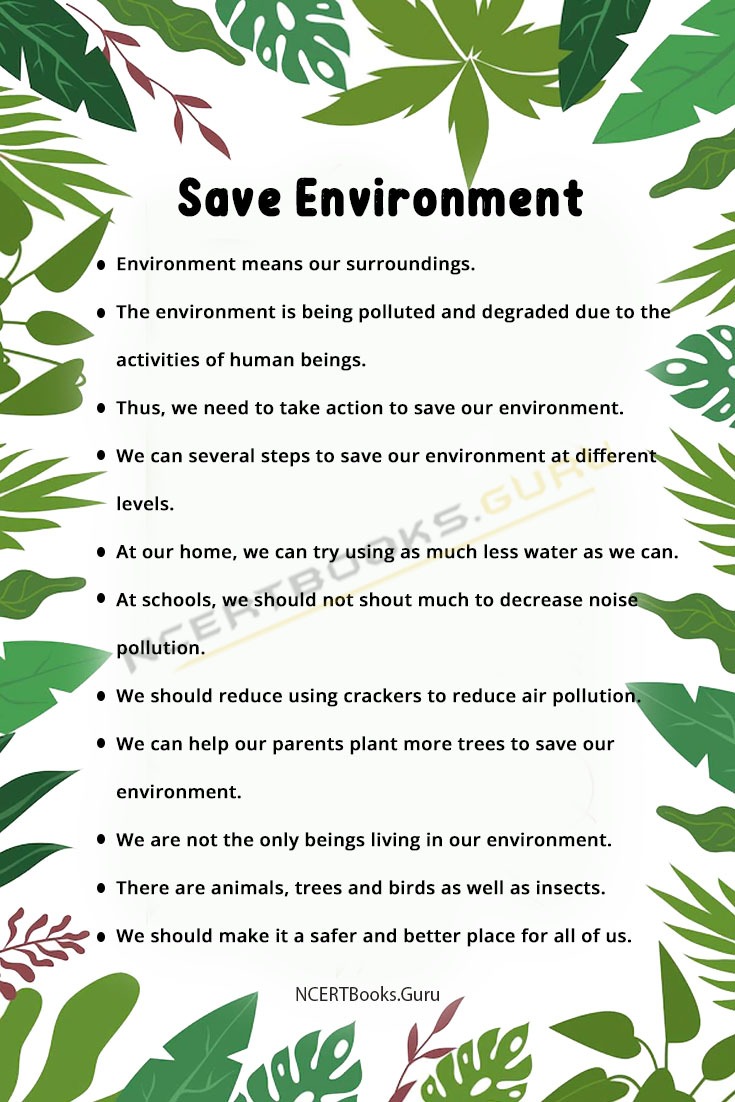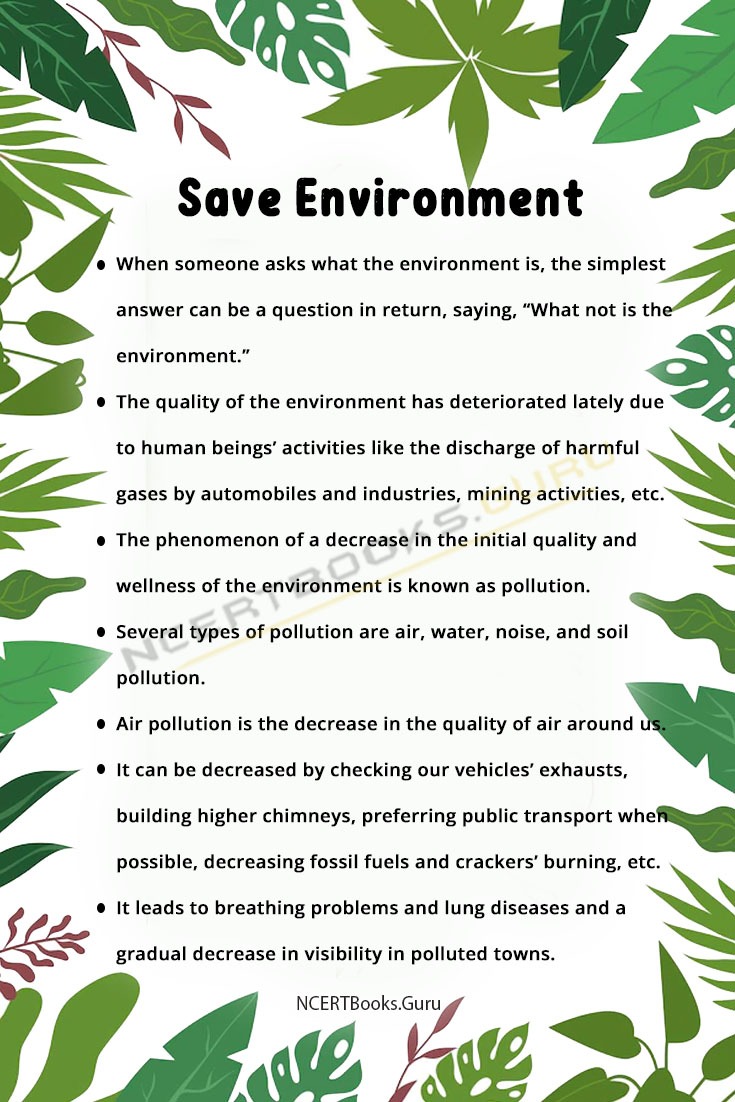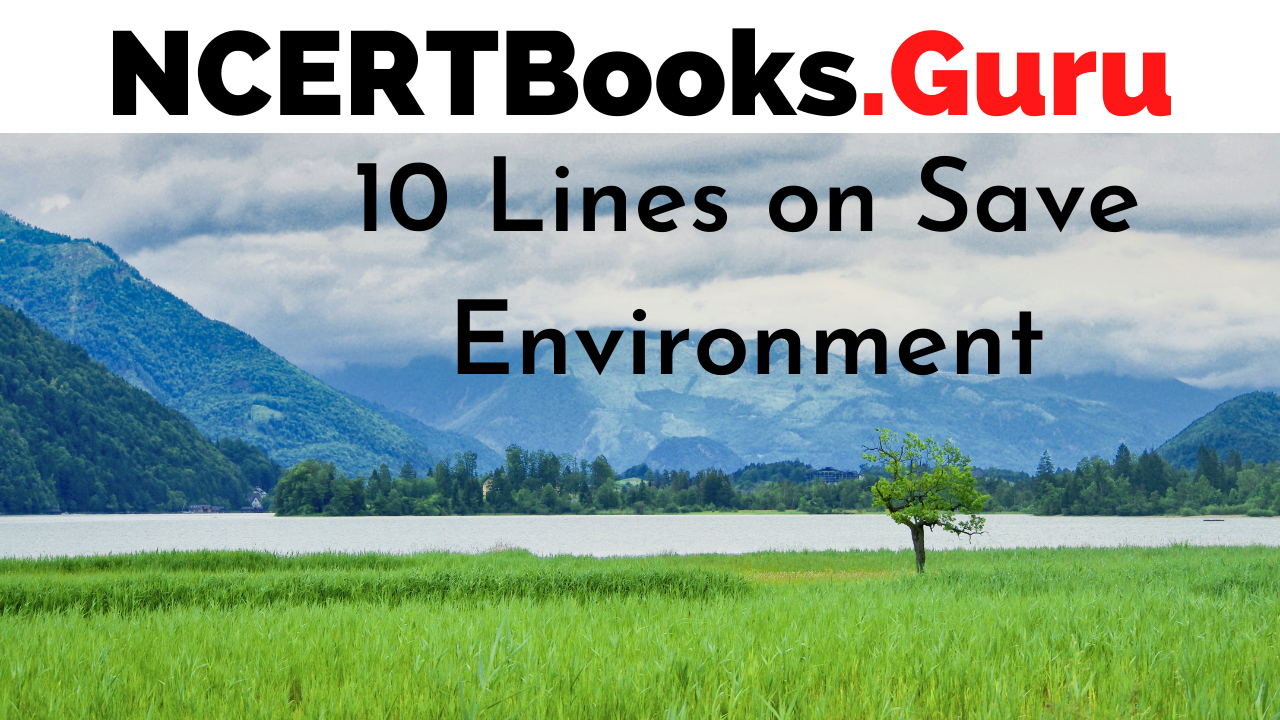10 Lines on Save Environment: The environment is the total of all the biotic and abiotic factors like air, water, soil, atmosphere, rocks, trees, etc., that make up the surrounding or niche of a living organism. We need to save the environment by using the latest technologies, and old-fashioned habits have decreased their quality.
Enhance your vocabulary and writing skills with 10 Lines Essays available. Spark up the creativity in you and access various Topics on 10 Lines all in one place.
Set 1 – 10 Lines on Save Environment for kids
Set 1 is helpful for students of Classes 1, 2, 3, 4 and 5.
- Environment means our surroundings.
- The environment is being polluted and degraded due to the activities of human beings.
- Thus, we need to take action to save our environment.
- We can several steps to save our environment at different levels.
- At our home, we can try using as much less water as we can.
- At schools, we should not shout much to decrease noise pollution.
- We should reduce using crackers to reduce air pollution.
- We can help our parents plant more trees to save our environment.
- We are not the only beings living in our environment. There are animals, trees and birds as well as insects.
- We should make it a safer and better place for all of us.

Set 2 – 10 Lines on Save Environment for School Children
Set 2 is helpful for students of Classes 6, 7 and 8.
- The environment can be defined as the niche of every living organism that includes the biotic and abiotic components.
- We, as human beings, are responsible for the quality deterioration of our environment by our activities.
- Several types of pollutions harm our environment like – air pollution, water pollution, noise pollution, soil pollution, etc.
- Air pollution is the decrease in the quality of air around us. It can be decreased by checking our vehicles’ exhausts, building higher chimneys, preferring public transport when possible, decreasing fossil fuels and crackers’ burning, etc.
- Water pollution is the pollution of water bodies by the contamination caused by sewages released to water bodies, throwing of debris and garbage of water bodies, natural siltation, idols’ immersion, discharging effluents from industries, etc.
- Noise pollution is the cumulative effect of shrill and high pitched noises in the atmosphere. The effects of this type of pollution cause harm to ground insects who become unstable due to screeching of horns, shrill and too high pitched noise disturb dogs, automobile sounds and construction sounds can be harmful to heart patients, students concentrating on their studies, etc.
- The main cause of soil pollution is fertilizers and pesticides, throwing of non – decomposable debris on to soil, etc.
- The environment is home to every living organism, and any pollution invariably decreases some individual’s survival chances.
- The need of the hour is to be cautious of our footprints and save the environment.
- We, as humans, must take up this duty as the foremost.
Set 3 – 10 Lines on Save Environment for Higher Class Students
Set 3 is helpful for students of Classes 9, 10, 11, 12 and Competitive Exams.
- When someone asks what the environment is, the simplest answer can be a question in return, saying, “What not is the environment.”
- The quality of the environment has deteriorated lately due to human beings’ activities like the discharge of harmful gases by automobiles and industries, mining activities, etc.
- The phenomenon of a decrease in the initial quality and wellness of the environment is known as pollution. Several types of pollution are air, water, noise, and soil pollution.
- Air pollution is the decrease in the quality of air around us. It can be decreased by checking our vehicles’ exhausts, building higher chimneys, preferring public transport when possible, decreasing fossil fuels and crackers’ burning, etc. It leads to breathing problems and lung diseases and a gradual decrease in visibility in polluted towns.
- Water pollution is the pollution of water bodies by the contamination caused by sewages released to water bodies, throwing of debris and garbage of water bodies, natural siltation, idols’ immersion, discharging effluents from industries, etc. By effectively treating sewage and discharges before sending them into water bodies and judicious use in household chores and day to day life, water pollution can be checked.
- Soil pollution is the most harmful type of pollution as it degrades the soil, the very base of life where creatures bountifully reside, and food grows. The main cause of soil pollution is fertilizers and pesticides, throwing of non – decomposable debris on to soil, etc. This can be checked by shifting to organic agriculture and reducing plastic wares use.
- Noise pollution is the cumulative effect of shrill and high pitched noises in the atmosphere. The effects of this type of pollution cause harm to ground insects who become unstable due to screeching of horns, shrill and too high pitched noise disturb dogs, automobile sounds and construction sounds can be harmful to heart patients, students concentrating on their studies, etc.
- Global warming is the outcome of environmental degradation, which is the eventual rise in the earth’s temperature due to air pollution. It causes the melting of glaciers and the subsequent consequences.
- Environment degradation, global warming, water footprint, and carbon footprint are the prime cause of concern in environmentalists’ minds today.
- Rome was not built in a day. So we can start today by judicious use of all resources and thus save the environment.

Frequently Asked Questions on Save Environment
Question 1.
What is the environment?
Answer:
The environment is the amalgam of biotic and abiotic factors that make up the surrounding or niche of a living organism.
Question 2.
What are the causes of air pollution?
Answer:
The causes of air pollution are as follows:
- use of mining practices
- burning of fossil fuels
- Exhaustive use of personal automobiles
- use of aerosols, etc.
